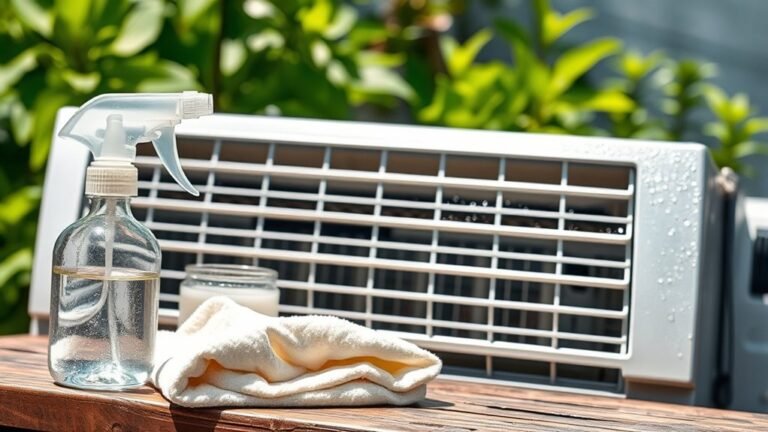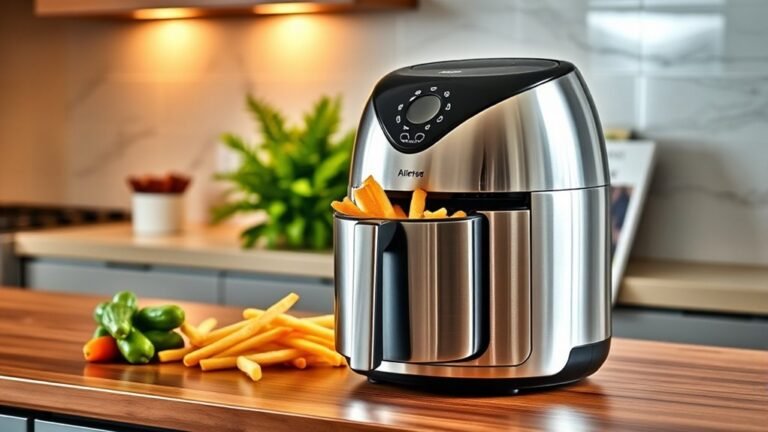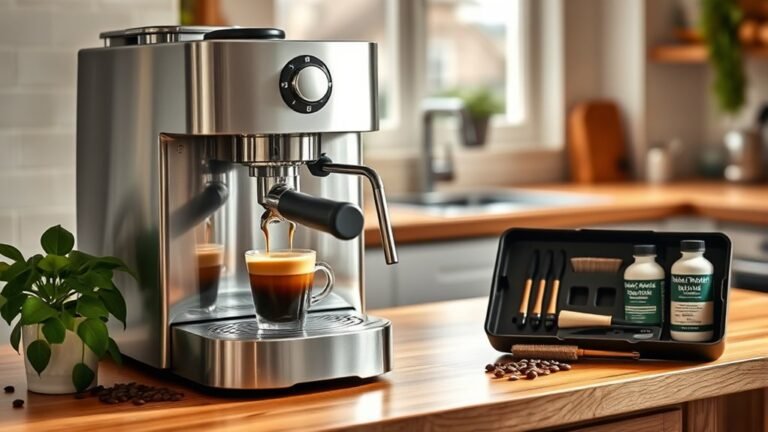Cleaning and Storing Holiday Lights Properly
To clean and store your holiday lights properly, first inspect each bulb and wire for damage or corrosion. Use a gentle, eco-friendly cleaner like mild soap and water with a soft cloth, avoiding harsh chemicals and excessive moisture. After wiping, hang them in a dry, ventilated space to air dry, then test for any faulty bulbs. Store your lights in durable, organized containers to prevent tangling and damage. Keep going to discover smart ways to extend their life and simplify storage.
Inspecting Your Holiday Lights for Damage

Before storing your holiday lights, you’ll want to inspect them carefully for any damage. A thorough light inspection guarantees your lights will work safely and reliably next season, giving you the freedom to decorate without worry. Start by examining each bulb for cracks or discoloration. Check the wires for frays, exposed copper, or signs of wear. Don’t forget to look at the plug and sockets for any corrosion or loose connections. This damage assessment helps you spot potential hazards early, so you can repair or replace faulty strands. Taking this simple step means you’re not forced into last-minute shopping or risking electrical issues later. By investing time in this damage assessment, you keep your holiday spirit bright and free from stress.
Cleaning Techniques for Different Types of Lights
You’ll want to use different cleaning methods depending on whether your lights are LED or incandescent since they have different sensitivities. Always choose safe materials like soft cloths and gentle cleaners to avoid damage. Let’s look at how to clean each type properly without risking harm.
LED Vs Incandescent Care
Although both LED and incandescent holiday lights brighten your festivities, they require different care when it comes to cleaning. You’ll want to preserve LED longevity and maintain incandescent brightness by treating each type properly. LEDs offer superior energy efficiency and lower heat emission, which affects how gently you clean them. Incandescents, with their warm color temperature and rich light quality, need careful handling to avoid damage.
Keep these tips in mind:
- Avoid harsh scrubbing on LEDs to protect delicate diodes
- Gently wipe incandescent bulbs to preserve brightness
- Use minimal moisture on LEDs to prevent electrical issues
- Check for heat damage on incandescents before storing
- Consider environmental impact and cost comparison when choosing your lights
This way, you’ll enjoy beautiful, long-lasting holiday illumination.
Safe Cleaning Materials
Since holiday lights come in different types and materials, choosing the right cleaning supplies is essential to avoid damage. You’ll want to steer clear of harsh chemicals that can wear down bulbs or wiring. Instead, opt for eco friendly solutions that are gentle yet effective. Homemade cleaners, like a mix of mild dish soap and water, work wonders without risking harm. For stubborn grime, a soft cloth dipped in your homemade mixture will clean without scratching or short-circuiting delicate parts. Avoid soaking lights; a damp cloth is safer. By using these safe cleaning materials, you maintain your lights’ longevity while embracing a greener approach. This way, you keep your holiday decorations shining bright, all while feeling free to care for them responsibly.
Drying and Testing Lights Before Storage

Before storing your holiday lights, make certain they’re completely dry to prevent damage or electrical issues later on. Using proper drying methods guarantees your lights stay in great shape for next year. After drying, you’ll want to run testing procedures to catch any faulty bulbs or strands.
Ensure holiday lights are fully dry before storage to avoid damage and electrical problems later.
Here’s a quick guide:
- Hang lights loosely in a dry, well-ventilated area to air dry naturally
- Avoid direct sunlight or heat sources that could warp bulbs or wires
- Use a soft cloth to wipe off any remaining moisture
- Plug in the strands and check each bulb and connection for functionality
- Replace or repair any damaged sections before packing
Taking these steps sets you free from surprises when you bring out your lights again!
Choosing the Right Storage Containers
When choosing storage containers for your holiday lights, focus on durable materials that protect against moisture and damage. Make sure the size fits your light strands without overcrowding, and consider options that help keep everything organized. This way, your lights stay safe and tangle-free until next season.
Durable Container Materials
Choosing the right storage containers for your holiday lights can make a big difference in keeping them safe and tangle-free. When picking durable materials, you want something that protects without limiting your freedom to store and access your lights easily. Here are some options to contemplate:
- Plastic bins: sturdy, waterproof, and stackable for easy storage.
- Metal boxes: offer excellent protection from crushing and pests.
- Cardboard containers: lightweight and eco-friendly but less durable.
- Fabric pouches: flexible and great for preventing scratches.
- Combination containers: mix materials for tailored protection.
Size and Organization Options
Durable materials are just one part of selecting the right container for your holiday lights. You’ll want to evaluate size options that fit your collection without wasting space. Too large, and lights shift around; too small, and you risk tangles or damage. Think about containers that allow you to separate strands by length, color, or type—this keeps things accessible and hassle-free. Incorporating smart organization strategies, like using dividers or wrapping lights around spools, can save you time and frustration next season. Clear bins offer visual freedom to quickly spot what you need. Ultimately, choosing containers that align with your storage space and lifestyle lets you store your lights efficiently, making decorating fun and freeing you from the usual clutter chaos.
Wrapping and Organizing Light Strands

One simple way to keep your holiday lights tangle-free is to wrap each strand individually around a spool or a piece of cardboard. This method boosts your light organization and makes strand management a breeze, giving you more freedom to enjoy your decorations without fuss. Here’s how you can wrap and organize efficiently:
Wrap each holiday light strand separately around cardboard for easy, tangle-free storage and quick decorating.
- Use sturdy cardboard pieces cut to size.
- Secure the ends with twist ties or rubber bands.
- Label each strand by length or color for quick access.
- Store wrapped strands upright in a bin to save space.
- Keep strands separated to avoid tangling and damage.
Tips for Preventing Damage During Storage
To keep your holiday lights in good shape, you’ll want to take a few simple steps during storage. Focus on light protection and moisture control to avoid damage. Store lights in a cool, dry place, and use airtight containers or sealed bags to keep moisture out. Avoid tangling by wrapping strands carefully. Label each container for easy access, so you’re free to decorate without hassle next season.
| What to Do | Why It Matters | How It Feels |
|---|---|---|
| Use airtight bags | Keeps moisture out | Secure and confident |
| Store in cool spots | Prevents heat damage | Calm and relaxed |
| Wrap strands gently | Avoids tangling | Organized and free |
| Label containers | Easy holiday prep | Prepared and ready |
| Avoid heavy stacking | Protects bulbs | Carefree and proud |
Frequently Asked Questions
Can I Use Holiday Lights Outdoors Year-Round?
You can use holiday lights outdoors year-round, but you’ll want to check their outdoor durability first. Most holiday lights are designed for seasonal usage, so prolonged exposure to weather might cause wear or damage. If you crave freedom to leave them up, pick lights rated for continuous outdoor use. That way, you’ll enjoy lasting brightness without worrying about safety or frequent replacements. Always follow manufacturer guidelines to keep your space festive and safe!
Are LED Lights More Energy-Efficient Than Incandescent?
When it comes to energy savings, LED lights are the cream of the crop compared to incandescent bulbs. You’ll find they use up to 80% less power, which means your freedom from high electric bills is right around the corner. Plus, their light longevity is miles ahead, lasting up to 25 times longer. So, if you want to shine bright without burning out your wallet or the bulbs, LEDs are your best bet.
How Do I Replace a Single Burned-Out Bulb?
When you spot a single burned-out bulb, start your bulb replacement by unplugging the lights for safety. Use troubleshooting tips like checking for loose bulbs or damaged sockets first. Gently twist or pull out the faulty bulb and swap it with a new one matching the correct voltage and size. Once replaced, plug the lights back in—this way, you keep your holiday vibe shining without hassle or restrictions.
What Safety Precautions Should I Take During Installation?
Imagine your neighbor once ignored installation safety and got shocked while hanging lights. To avoid electrical hazards, you should always unplug lights before working on them and use insulated tools. Don’t overload outlets, and check for damaged wires before installation. Also, opt for lights rated for outdoor use if outside. These steps help you stay safe while decorating, letting you enjoy the freedom of a festive home without risking injury.
Can Holiday Lights Be Recycled After Use?
You might wonder if holiday lights can be recycled after use. The good news is, yes, holiday light recycling programs exist to help you with eco friendly disposal. Don’t just toss them in the trash; many communities or retailers offer drop-off points so you can give your lights a second life. By choosing holiday light recycling, you’re freeing yourself from waste guilt and helping protect the planet.






